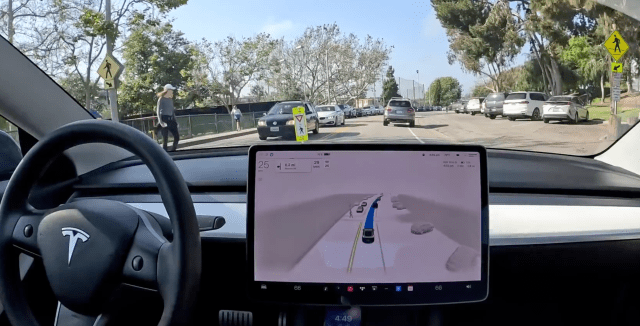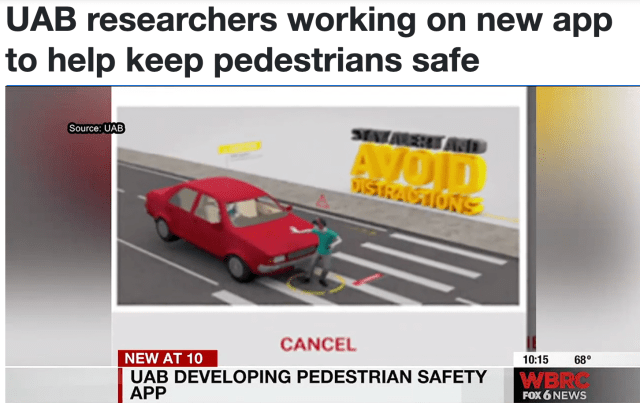Pedestrian Safety: There’s No Technical Fix
This article was originally published on Joe Cortright’s blog, City Observatory. It is shared here with permission. All images for this piece were provided by the author unless otherwise indicated.
Sooner than many of us thought possible, self-driving cars are in testing on city streets around the country. While a central promise of autonomous vehicle backers has been that this technological advance would eliminate road carnage, there’ve been good reasons to be skeptical. A viral video of a driverless Tesla blowing past a pedestrian in a marked crosswalk (where the opposing traffic was already stopped) serves as a social media litmus test for people’s view of traffic safety.
See? The self-driving Tesla drives just like a human: with blatant disregard for pedestrians.
Autonomous car advocates seem to think that the video shows the technology is just like humans, with the same cavalier attitude toward people outside vehicles, prioritizing getting there faster over endangering human life—“I mean, the vehicle didn’t actually hit the pedestrian, am I right?” Others point out that the self-driving Tesla flagrantly violated state law, with zero consequences: Nobody is tracking down Elon Musk or a software engineer to hand out a citation (or, but for a few feet, an arrest warrant for manslaughter).
There seems to be little improvement from the first days of “self-driving” technology. In 2016, City Observatory reported on a self-driving Uber being tested on the streets of San Francisco that had blown through a red light in front of a pedestrian in a marked crosswalk.
To Engineers, We’re Always Just One More Technology Away From Safer Streets
Some years back, Google unveiled a novel plan to coat the exterior of self-driving cars with a special adhesive that would cause any pedestrians the vehicles struck to adhere to the car, rather than being thrown by the impact. Whether it would be better to find oneself stuck to the car that struck you, rather than being pushed aside, is far from clear. But pedestrian safety in a world of self-driving cars is clearly an issue that needs to be dealt with.
In that vein, the best engineering minds of the University of Alabama, Birmingham (UAB), are on the case, and have come up with—you guessed it—a smartphone app to “protect” pedestrians. The idea is that it would detect the presence of nearby cars and signal a warning to a user that they ought to stop looking at their phone, because, you know, the leading cause of injuries and fatalities is pedestrian distraction. (Or so it seems to car-blinded engineers.)
A hat tip to Denver’s Jim Charlier, who observed on twitter:
The idea that an app on your phone can protect you from being hit by a driver is such a profound misreading of the actual problem, it’s hard to know where to even start.
We also have to point out that the UAB app is pretty plainly an infringement on an idea that we at City Observatory put forth seven years ago: the pedestrian shock bracelet. We proposed it with tongue firmly in cheek, but we know the UAB engineers are, no doubt, deadly serious.
Pedestrian Shock Bracelets
Most pedestrians are already instrumented, thanks to cell phones, and a large fraction of pedestrians have fit-bits, apple watches, and other wearable, Internet-connected devices. We propose adding a small electroshock device to these wearables, and making it accessible to the telematics in autonomous vehicles. In the event that the autonomous vehicle’s computer detects the likelihood of a car–pedestrian collision, it could activate the electroshock device to alert the pedestrian to, say, not step off the curb into the path of an oncoming vehicle.
(Source: City Observatory/Matt Cortright.)
As long as we’re mulling a technical fix that comports with a car-centric, victim-blaming view of traffic safety, let us remind you of a couple of our other ideas. (And if you don’t like these concepts, UAB, give us a call: we’ve got plenty more like these!)
Personal Airbags
Airbags are now a highly developed and well-understood technology. Most new cars have a suite of frontal impact, side curtain, and auxiliary airbags to insulate vehicle passengers from collisions. The next frontier is to deploy this technology on people, with personal airbags. Personal airbags could have their own sensors, inflating automatically when the pedestrian is in imminent danger of being struck by a vehicle.
(Source: City Observatory/Matt Cortright.)
Rocket Packs
While a sufficiently strong adhesive might keep a struck pedestrian from flying through an intersection and being further injured, perhaps a better solution would be to avoid the collision entirely by lifting the pedestrian out of the way of the collision, in the first place. If pedestrians were required to wear small but powerful rocket packs, again connected to self-driving cars via the Internet, in the event of an imminent collision, the rocket pack could fire and boost the pedestrian clear of the oncoming vehicle.
(Source: City Observatory/Matt Cortright.)
We offer these ideas in jest, to underscore the deep biases we have in thinking about how to adapt our world for new technology. As we’ve pointed out before, while these inventions are advertised as “pedestrian” safety devices, they’re really only necessary because of the danger posed by cars. The real purpose of this technology is to free drivers from the need and responsibility to look out for pedestrians, so that they can drive faster.
It has long been the case with private vehicle travel that we’ve demoted walking to a second-class form of transportation. The advent of cars led us to literally re-write the laws around the “right of way” in public streets, facilitating car traffic, and discouraging (and in some cases criminalizing) walking. We’ve widened roads, installed beg buttons, and banned “jaywalking” to move cars faster, but in the process making the most common and human way of travel more difficult and burdensome, and made cities less functional.
Everywhere we’ve optimized the environment and systems for the functioning of vehicle traffic, we’ve made places less safe and less desirable for humans who are not encapsulated in vehicles. A similar danger exists with this kind of thinking when it comes to autonomous vehicles; a world that works well for them may not be a place that works well for people.
Consider the “Drivewave” proposal from MIT Labs and others to eliminate traffic signals and use computers to regulate the flow of traffic on surface streets. The goal is to allow vehicles to never stop at intersections, but instead travel in packs that create openings in traffic on cross streets that allowed crossing traffic to flow through without delay. Think of two files of a college marching band crossing through one another on a football field.
It’s thoroughly possible to construct a computer simulation of how cars might be regulated to enable this seamless, stop-free version of traffic flow. But this worldview gives little thought to pedestrians—the video illustrating Drivewave doesn’t show any pedestrians, although the project description implies they might have access to a new form of beg button to part traffic flows to enable crossing the street. That might be technically feasible, but as CityLab’s Eric Jaffe pointed out, “it would be a huge mistake for cities to undo all the progress being made on human-scale street design just to accommodate a perfect algorithm of car movement.”
Not all of our problems can be solved with better technology. At some point, we need to make better choices and design better places, even if it means not remaking our environment and our communities to accommodate the more efficient functioning of technology.
Thanks to Matt Cortright for providing the diagrams for our proposed pedestrian protection devices.
Joe Cortright is President and principal economist of Impresa, a consulting firm specializing in regional economic analysis, innovation and industry clusters. Over the past two decades he has specialized in urban economies, developing the City Vitals framework with CEOs for Cities, and developing the city dividends concept.
Joe’s work casts a light on the role of knowledge-based industries in shaping regional economies. Prior to starting Impresa, Joe served for 12 years as the Executive Officer of the Oregon Legislature’s Trade and Economic Development Committee. When he’s not crunching data on cities, you’ll usually find him playing petanque, the French cousin of bocce.








On this episode of the Strong Towns Podcast, Chuck discusses safe streets advocacy with Amy Cohen, the co-founder and president of Families for Safe Streets.